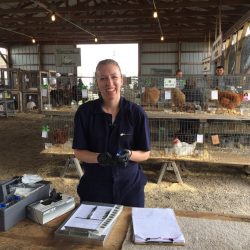With more than 30 years of experience—24 of them at MSU—avian pathologist R.M. “Mick” Fulton, DVM, PhD, associate professor for the Department of Pathobiology and Diagnostic Investigation, has encountered almost every scenario possible for a poultry scientist. He teaches veterinary students about avian disease, diagnosis, treatment, and prevention; he makes farm calls as an MSU Extension poultry veterinarian; he conducts necropsies in the MSU Veterinary Diagnostic Laboratory; he educates professional and hobby poultry farmers about preventing disease; he served on the front lines when H5N1 avian influenza was spreading through Asia and Europe; and he’s been involved in the design and construction of three animal diagnostic laboratories including one in Afghanistan.
“I knew I wanted to be a veterinarian since I was in fourth grade,” Fulton says. “Originally, I wanted to work with cattle, but I had a job when I was in veterinary medical school cleaning the pathology laboratory floor, and I learned a lot there. Then, my last year of school, I took an avian pathology course. The instructor was very dynamic and I found it very interesting.”
After working in both large and small animal practices, Fulton decided he wanted to be a poultry pathologist and earned his doctorate from Purdue, where he was involved in the building of the diagnostic laboratory while serving on the faculty there.
When the MSU Veterinary Diagnostic Laboratory was being constructed, Fulton was asked to design part of the necropsy laboratory and make it functional. Then, in 2005, the US Agency for International Development (USAID) asked MSU to help construct a laboratory (similar to MSU’s) in Afghanistan to help train veterinary medical students, as well as rebuild its agriculture and food industry.
Fulton traveled to Kabul University in Afghanistan three times, once to design the necropsy area, once to secure three years’ worth of supplies for the facility, and finally, to teach proper facility use and help reestablish a veterinary pathology teaching program at the University.
“Necropsy was a way to establish a disease surveillance and reporting system to help the Afghans be more self-sufficient in terms of feeding the country’s people,” Fulton says.
Fulton’s expertise also has taken him to Rwanda to help the country develop a plan to deal with H5N1 avian influenza.
“In order to receive funding from the World Bank, every country had to have a plan on how it was going to deal with H5N1 avian flu,” Fulton explains. “Dan Clay, director of the MSU Global Programs in Sustainable Agrifood Systems, was working in Rwanda and asked me to travel to the country and evaluate its preparedness for avian flu, as well as review the country’s plan. I did, and it was clear that what they had was not going to work for them. In many cases, countries were just copying other countries’ plans without considering that the plan that worked for one country—like the one from Australia—may not work for another country—such as Africa. So, I went to Rwanda and helped the officials rewrite their plan to make it actionable, taught them about biosecurity and how to use the personal protective equipment, and also ran some tabletop exercises with them on actions to take in various situations.”
Fulton also worked with USAID on the Stamping Out Pandemic and Avian Influenza (STOP AI) program; consulted with and taught officials in Mongolia, Moldova, Macedonia, Transnistria, Egypt, Nepal, and Bulgaria on preparedness planning, surveillance, and prevention; and focused on outbreak response, recovery, and reinfection prevention. In Bulgaria and Michigan, he also orchestrated and led active table top- and farm-based exercises.
“It was very rewarding to know that people were prepared,” Fulton says. “It also helped increase my understanding of international needs in terms of technical resources and support services.”
At MSU, Fulton is the point person for nearly all avian disease and diagnostics issues. He works with producers of all sizes across the state, from the family with a few backyard chickens to a farm with 2.5 million egg-laying chickens, to people with exotic avian species as pets. He also spends part of every day in the necropsy laboratory, conducting pathological exams on birds that people have brought in and diagnosing the cause of death. He also contributes individual lectures in multiple courses in the College and travels to other universities that lack expertise in poultry science to conduct intensive training seminars.
“Avian medicine is practiced at the highest level,” Fulton explains. “We’re the early adopters. We were the first species-focused veterinarians to use DNA fingerprinting and genetic modification of bacteria and viruses for vaccines. It’s almost required because of the size of the farms. The replacement cost for one egg-laying chicken is $7, so a producer with 2.5 million birds has more than $17 million invested in just the chickens. That doesn’t count the structures or the food or the animal care. Keeping the birds healthy is paramount.”



